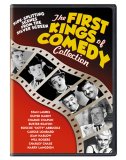| Reviews & Columns |
|
Reviews DVD TV on DVD Blu-ray 4K UHD International DVDs In Theaters Reviews by Studio Video Games Features Collector Series DVDs Easter Egg Database Interviews DVD Talk Radio Feature Articles Columns Anime Talk DVD Savant Horror DVDs The M.O.D. Squad Art House HD Talk Silent DVD
|
DVD Talk Forum |
|
|
| Resources |
|
DVD Price Search Customer Service #'s RCE Info Links |
|
Columns
|
|
|
First Kings of Comedy Collection
Sometimes it's easy to take for granted how easy film buffs have it nowadays. With DVDs, VHS tapes, the Internet, and 100 cable channels if you want to watch a particular film, it's usually pretty easy to do so. I remember growing up in the late 60's/early 70's however and desperately yearning to be able to see certain movies. I would spend hours pouring over the pages of Famous Monsters of Filmland (the original version, not the crap that Ray Ferry puts out) and wishing that I could see some of the films that were being discussed. Of course those movies would occasionally turn up on late night TV or the Saturday Afternoon Creature Feature, not so with silent films. For decades it was nearly impossible to see any silent features or shorts, unless you were lucky enough to live in a town with a revival theater, and even then you were usually limited to catching Nosferatu and The Hunchback of Notre Dame around Halloween. That's where Robert Youngson comes into the picture.
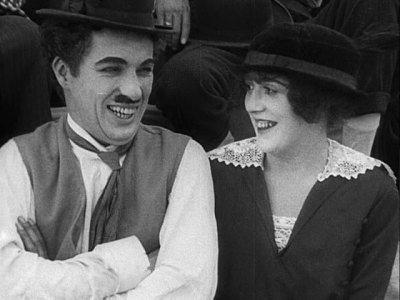 Silent movies were all but forgotten in the public mind by 1958. That year Robert Youngson put out The Golden Age of Comedy, his first compilation movie of gags culled from old comedy shorts and it was a big success. He followed it up with When Comedy was King a year later. By 1970 Youngson had created eight feature lenght compilations and almost single handedly revived interest in the comedies of the silent era. Not only did he remind people that these films were funny, he made them available. Now these two earliest Youngson films are available (at long last) on a single DVD.
Silent movies were all but forgotten in the public mind by 1958. That year Robert Youngson put out The Golden Age of Comedy, his first compilation movie of gags culled from old comedy shorts and it was a big success. He followed it up with When Comedy was King a year later. By 1970 Youngson had created eight feature lenght compilations and almost single handedly revived interest in the comedies of the silent era. Not only did he remind people that these films were funny, he made them available. Now these two earliest Youngson films are available (at long last) on a single DVD.
Both of these films present the early comedies in the same way: the take the funniest scenes from a short, add narration to set up the scene, and let the comedy unfold. These excerpts are presented with full orchestrated music and some well placed sound effects. The narration is often useful, but can get a bit tiresome when Youngson tries to add some verbal comedy. These jokes always pale in comparison to the action on screen.
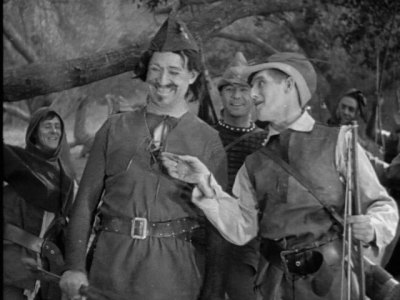 The Golden Age of Comedy was intended to be a short, but when Youngson came to an agreement with Hal Roach Studios and gained access to their library, the idea was expanded to a full length feature. This first feature includes clips of Ben Turpin, Billy Bevan, and Charley Chase. There's an extended sequence featuring Will Rogers where he parodies Hollywood movies. Taken from both Big Moments from Little Pictures and Uncensored Hollywood these are the funniest bits from Rogers 2-reel period with Roach all strung together. He does a wonderful skewering of Douglas Fairbanks in Robin Hood, and his Tom Mix sketch, including over-sized hat and a horse that can outrun cars, is hilarious. Carole Lombard also has some time on screen with an excerpt from Run, Girl, Run (thanks to Harry H. for coming up with the name!) where she plays a track athlete who would rather powder her nose than run a race, much to her coach's dismay.
The Golden Age of Comedy was intended to be a short, but when Youngson came to an agreement with Hal Roach Studios and gained access to their library, the idea was expanded to a full length feature. This first feature includes clips of Ben Turpin, Billy Bevan, and Charley Chase. There's an extended sequence featuring Will Rogers where he parodies Hollywood movies. Taken from both Big Moments from Little Pictures and Uncensored Hollywood these are the funniest bits from Rogers 2-reel period with Roach all strung together. He does a wonderful skewering of Douglas Fairbanks in Robin Hood, and his Tom Mix sketch, including over-sized hat and a horse that can outrun cars, is hilarious. Carole Lombard also has some time on screen with an excerpt from Run, Girl, Run (thanks to Harry H. for coming up with the name!) where she plays a track athlete who would rather powder her nose than run a race, much to her coach's dismay.
The highlights of the film are the Laurel and Hardy sections. The Boys, as they were known, really steal the show. The pie fight scene from Battle of the Century (probably the best scene of its kind ever shot) is included, as well as bit where they escape from jail in The Second Hundred Years dressed as painters and have to convince a suspicious police officer that they really are workmen. They do this, naturally, by painting: a car, the street, store windows, and even a woman's backside. There's also an extended scene from one of their best films, Two Tars. Youngson was wise enough to include the whole traffic jam scene were Stan and Ollie, playing two sailors on shore leave, get into a battle with other drivers when they try to cut in line. The escalating violence is truly outragous.
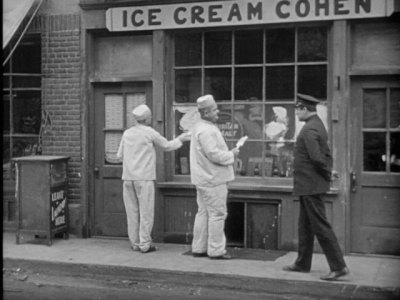 The next film, When Comedy was King, was just as hilarious. This time the Charlie Chase film Movie Night is used as a framing sequence to present the clips, which is a good idea and works very well. This time some of the bigger names in silent film are featured, and the movie starts off with some of Charlie Chaplin's work that he did while he was at Keystone. There's the famous snippet from 1914's Kid Auto Races at Venice where Chaplin first tries on the big shoes, tight pants, and a cane that he would eventually turn into "The Tramp" as well as other clips from his early days in film. These aren't Chaplin's best bits, but Youngson didn't have access to Chaplin's features and other shorts.
The next film, When Comedy was King, was just as hilarious. This time the Charlie Chase film Movie Night is used as a framing sequence to present the clips, which is a good idea and works very well. This time some of the bigger names in silent film are featured, and the movie starts off with some of Charlie Chaplin's work that he did while he was at Keystone. There's the famous snippet from 1914's Kid Auto Races at Venice where Chaplin first tries on the big shoes, tight pants, and a cane that he would eventually turn into "The Tramp" as well as other clips from his early days in film. These aren't Chaplin's best bits, but Youngson didn't have access to Chaplin's features and other shorts.
Buster Keaton gets a section in this film. His funniest short, Cops, is shown nearly in its entirety. This laugh-out-loud funny picture has Buster accidentally throwing a bomb at the mayor during a police parade. With the entire force after him, it's up to Keaton's nimble body and mind to outsmart and out think the coppers. It's interesting to note that during this short Youngson names Keaton as one of the three great comic talents of the silent age. While that's not surprising at all, the fact that Harry Langdon is on the list along with Charlie Chaplin is.
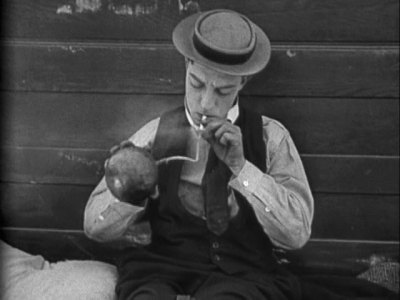 Once again Laurel and Hardy steal the film with an extended clip (nearly complete as far as I can tell) from Big Business. This is the film where the boys are door-to-door Christmas tree salesmen (as if that wasn't absurd enough in and of itself...) who get into a battle with James Finlayson when he snubs them. Like with Two Tars, the violence escalates at a rapid pace until Finlayson's house lay in ruins. One interesting note about this short: The story may be apocryphal, but according to Hollywood legend, Roach made an agreement to film this movie at a house that was going to be demolished. They let loose breaking windows and generally trashing the place and it wasn't until the homeowner arrived that they discovered that they were at the wrong house.
Once again Laurel and Hardy steal the film with an extended clip (nearly complete as far as I can tell) from Big Business. This is the film where the boys are door-to-door Christmas tree salesmen (as if that wasn't absurd enough in and of itself...) who get into a battle with James Finlayson when he snubs them. Like with Two Tars, the violence escalates at a rapid pace until Finlayson's house lay in ruins. One interesting note about this short: The story may be apocryphal, but according to Hollywood legend, Roach made an agreement to film this movie at a house that was going to be demolished. They let loose breaking windows and generally trashing the place and it wasn't until the homeowner arrived that they discovered that they were at the wrong house.
Like the first film, this one is filled with laughs and some classic slapstick. (I loved the Snub Pollard clips...he deserved more recognition.) Together these films are a great introduction to the world of silent comedy.
The DVD:
Video:
The full frame video quality was very good over all. Youngson had access to the Hal Roach vaults and most of the clips look great. The contrast is superb, the image sharp, and the level of detail excellent. The blacks are generally solid and there isn't any blooming and details don't disappear when a shadow falls over someone. Yes, there is some print damage to some of the films, spots and the occasional scratch, and one segment, a Will Rogers clip, had started to deteriorate just slightly but these were fairly rare, especially when taking into consideration that this film was compiled before computer restoration was even a valid concept, much less a reality.
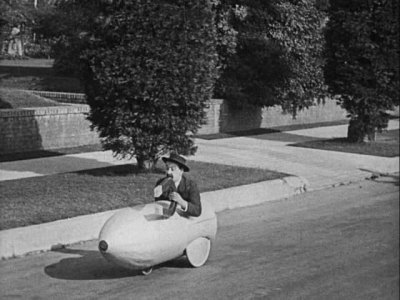 There are some slight digital artifacts in the films. There's a touch of dot crawl on the opening titles to both films, but it is very minor. In the second feature there is a problem with digital noise however. This is most notable in the wide shots of the theater screen that opens each chapter of the film. The walls jiggle and move like they are alive. Though it is present in several spots, it never gets to be a distraction.
There are some slight digital artifacts in the films. There's a touch of dot crawl on the opening titles to both films, but it is very minor. In the second feature there is a problem with digital noise however. This is most notable in the wide shots of the theater screen that opens each chapter of the film. The walls jiggle and move like they are alive. Though it is present in several spots, it never gets to be a distraction.
Audio:
Since the image looked so good, I was surprised at the mediocre quality of the audio tracks. Granted these were recorded nearly 50 years ago, but I was expecting a bit more. The two channel mono soundtracks to both films had very little range with both the highs and lows being clipped. This was most evident in the music that accompanied the shorts. What's worse is that there was distortion in more than one scene with the narrator's voice cracking and words sounding slurred. In all probability this was on the master that was used for the transfer, but it's still unfortunate.
Extras:
I was really disappointed that there weren't any extras on this disc. A couple of silent shorts featuring Billy Bevan or Ben Turpin would have been great.
Final Thoughts:
These two films went a long way towards keeping silent comedy, and silent comedians, alive through the sixties and seventies. Filled with hilarious slapstick, these are both great films that give a great overview of some of the many comic stars from the early days of film. Not just focusing on Keaton, Chaplin, and Laurel and Hardy, there are also clips from many lesser known but nearly as talented clowns as Snub Pollard, Harry Langdon, Billy Bevan, Andy Clyde, and Ben Turpin. A great collection that is well worth the price of admission. Highly Recommended.
|
| Popular Reviews |
| Sponsored Links |
|
|
| Sponsored Links |
|
|
| Release List | Reviews | Shop | Newsletter | Forum | DVD Giveaways | Blu-Ray | Advertise |
|
Copyright 2024 DVDTalk.com All Rights Reserved. Legal Info, Privacy Policy, Terms of Use,
Manage Preferences,
Your Privacy Choices | |||||||









